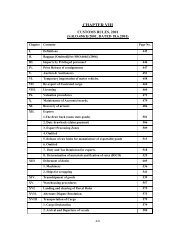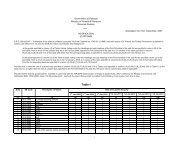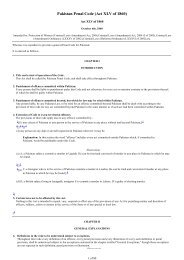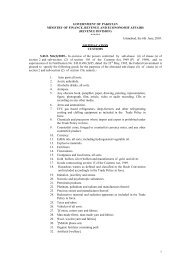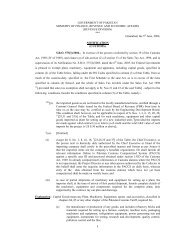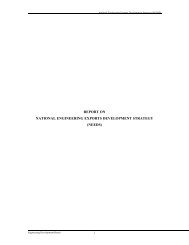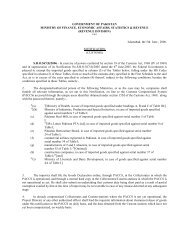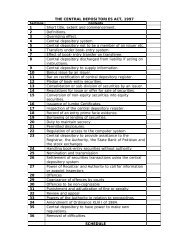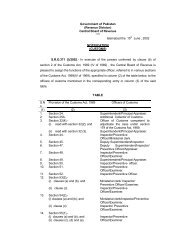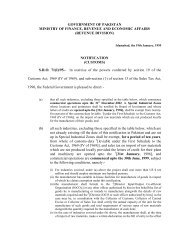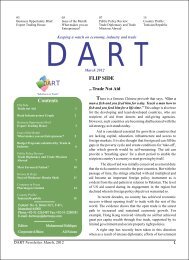47. Pakistan Economic Survey 2011-12 - Consultancy Services in ...
47. Pakistan Economic Survey 2011-12 - Consultancy Services in ...
47. Pakistan Economic Survey 2011-12 - Consultancy Services in ...
You also want an ePaper? Increase the reach of your titles
YUMPU automatically turns print PDFs into web optimized ePapers that Google loves.
<strong>Pakistan</strong> <strong>Economic</strong> <strong>Survey</strong> <strong>2011</strong>-<strong>12</strong>(FWC) dur<strong>in</strong>g 2010-11. The FWC is one of thema<strong>in</strong> service delivery networks of the programestablished <strong>in</strong> rural and urban areas for theprovision of Mother Child Health <strong>Services</strong>(MCH), contraceptives and the treatment ofm<strong>in</strong>or ailments. Reproductive Health <strong>Services</strong>-A Centres(RHSA) are hospital based units which providethe full range of family plann<strong>in</strong>g methods<strong>in</strong>clud<strong>in</strong>g contraceptive surgery services.These centres also assist <strong>in</strong> public healtheducation campaigns and rais<strong>in</strong>g awarenessabout personal hygiene. There are 207 RHS-Acentres function<strong>in</strong>g throughout the country.Table-<strong>12</strong>.5: Physical and Contraceptive Users TargetsAt present 292 Mobile Service Units (MSU)are function<strong>in</strong>g <strong>in</strong> the country. The MSUextends reproductive health and familyplann<strong>in</strong>g services to villages through regular(twice a week) camp<strong>in</strong>g services.The hospitals registered as RHS-B Centres areprovid<strong>in</strong>g tra<strong>in</strong><strong>in</strong>g for doctors and paramedics.Dur<strong>in</strong>g 2010-11, the government launched 133RHS-B Centers.Registered Medical Practitioners, Hakims andHomeopaths are a significant source of healthcare provision <strong>in</strong> both the urban and rural areasof the country.(Cumulative Number) Name of ServiceOutlet / Unit2010-11(Target)2010-11(Achievement)<strong>2011</strong>-<strong>12</strong>(Target)Public SectorFamily Welfare Centers (FWCs) 3084 2891 3427Reproductive Health-A Centers 258 207 269Mobile Service Units (MSUs) 293 292 300Contraceptive users (million) 9.953 2.734 10.241Private SectorRHS-B Centers 145 133 184Registered Medical Practitioners 24273 9297 27576(RMPs)Hakeems and Homeopaths 13925 8071 14009Source: Plann<strong>in</strong>g and Development DivisionUrbanizationUrbanization is a process which <strong>in</strong>volves theabsolute and relative growth of towns and citieswith<strong>in</strong> def<strong>in</strong>ed areas. Major reasons forurbanization are better economic opportunities andliv<strong>in</strong>g conditions as compared to rural areas. Dueto the grow<strong>in</strong>g needs and limited workopportunities people are rapidly mov<strong>in</strong>g towardsurban centers. Resultantly urbanization has beenaccelerated worldwide. This is the first time <strong>in</strong>human history that the majority of the world'spopulation has been shifted to urban areas. Atpresent 3.3 billion people (more than one half ofworld population) are liv<strong>in</strong>g <strong>in</strong> urban areas. It ispredicted that by 2030 at least 60 percent of thepopulation will be liv<strong>in</strong>g <strong>in</strong> cities. In develop<strong>in</strong>gcountries, about 60 million people move from ruralto urban areas each year and this rate of movementis expected to cont<strong>in</strong>ue.In <strong>Pakistan</strong> cities are grow<strong>in</strong>g rapidly as a result ofthe movement of people from rural areas <strong>in</strong> searchof jobs, opportunities to improve their lives andmake a better future for their children. Moreoverthe lack of basic facilities <strong>in</strong> rural areas likeelectricity, sanitation, safe dr<strong>in</strong>k<strong>in</strong>g water andschool<strong>in</strong>g are some of the reasons for rapidurbanization. The population <strong>in</strong> urban areas<strong>in</strong>creased from 65.28 million <strong>in</strong> <strong>2011</strong> to 67.55million <strong>in</strong> 20<strong>12</strong>. This means that with<strong>in</strong> a year, twomillion people shifted from rural to urban areas <strong>in</strong><strong>Pakistan</strong>. The annual population growth <strong>in</strong> urbanareas is expected to <strong>in</strong>crease further <strong>in</strong> com<strong>in</strong>gyears which may cause socio economic problems<strong>in</strong> future.In order to cope with the situation, the governmentis not only try<strong>in</strong>g to create a better economic andhealthy environment <strong>in</strong> urban areas but alsoprovide basic facilities <strong>in</strong> slum areas. Some of thereforms to manage urbanization are:166



